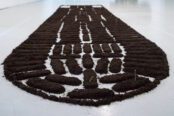[dropcap style=”font-size:100px;color:#992211;”]A[/dropcap]rt is meant to be known, to be seen, to be remembered. Paul Harfleet’s Pansy Project is a subtle way of remembering the violent acts of the past and recontextualising them as acts of beauty.
It’s hard to define Harfleet’s practice exactly. His methodology around The Pansy Project is to plant pansies at sites of homophobic abuse generally without civic permission. The unlabelled piece is then photographed in its location and posted on Harfleet’s website, and the image is entitled after the abuse. “Let’s kill the Bati-Man!” and “Fucking Faggot!” reveal a frequent reality of gay experience which often goes unreported, ignored or taken for granted. Intersecting aspects of performance art, street art, conceptual art, politics, psychogeography and montage, his approach has a naivety which stays with the viewer.
Creating these works outside of civic permission might be a representation of both the inaction of people around the violent events and in some way an entreaty for good people to not stand around and do nothing. It is certainly an act of remembrance for the violence, the victim and the aggressor but also for those around the act that failed to stop it from happening. Violence against certain groups easily becomes normalised as ‘what happens to people of that sort’, not necessarily reaching others. It’s objectified as being outside of my experience and regardless of your stance on homosexuality equalled remote. The everyday appearance of the pansy, in many ways a humble and delicate flower that rarely causes comment, even amongst horticulturalists, reflects the ‘as it is’ connection between the perception of homosexuals and these violent acts. That the flowers themselves flourish or die is a none too subtle analogy for how these commonplace events affect lives, mirroring that the artwork itself is not a deep read and yet moving for its simplicity, perhaps more so because it is so direct. It might be that the surface level of understanding around the work is in itself part of the methodology. Everyone likes a flower, they naturally appear almost everywhere, and yet we’ve created a world where the natural appears surreal.
Since 2005 Harfleet’s simple artwork operates as a gesture of quiet resistance; some pansies flourish and others wilt in urban hedgerows. Initially planting pansies to mark his own experience of homophobia on the streets of Manchester he now plants them internationally as part of various festivals and events. To date he has planted almost 300 individual flowers at sites of homophobia with the documentation of his work being exhibited internationally, culminating in 2015 with the documentary Les Pensées De Paul, commisioned by CANAL+.
Speaking to Trebuchet, Harfleet discusses simplicity of process and what the project still means to him some 13 years after its inception.
You started the project in 2005. What was the catalyst for it?
I was doing an MA at the time in fine art, and beginning to make work on the street. One day I experienced three separate incidents of homophobia and that’s what instigated it and led me to start researching the kind of work I could make about that.
Read this article in full in Trebuchet 5 – Art and Crime

Trebuchet Issue 5 Art and Crime

The aim of art is to represent not the outward appearance of things, but their inward significance. – Aristotle






















